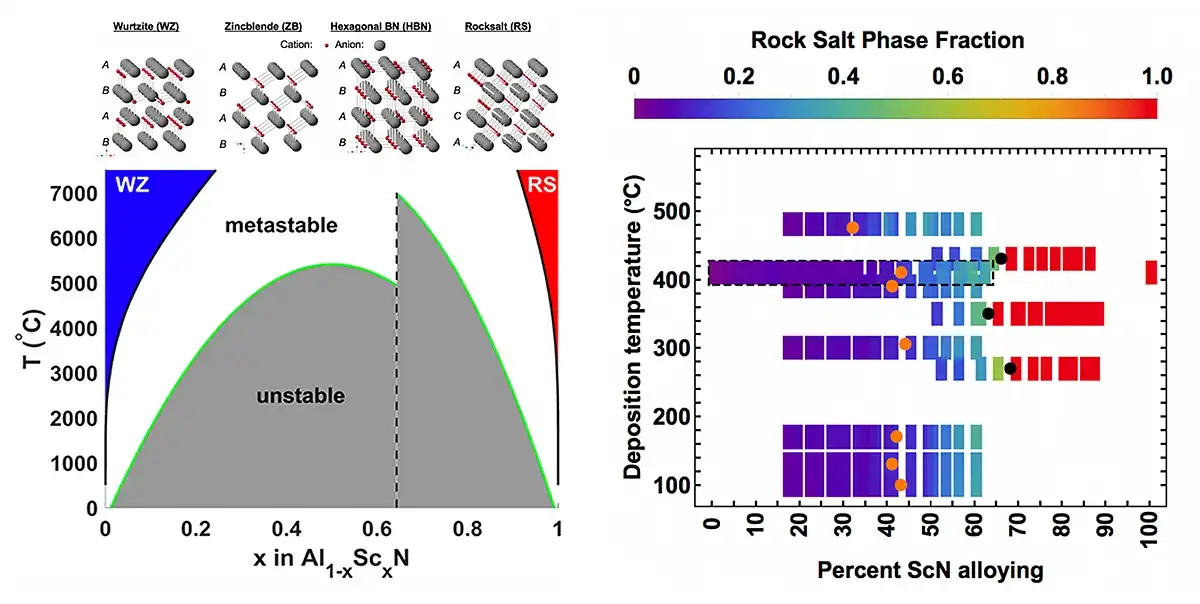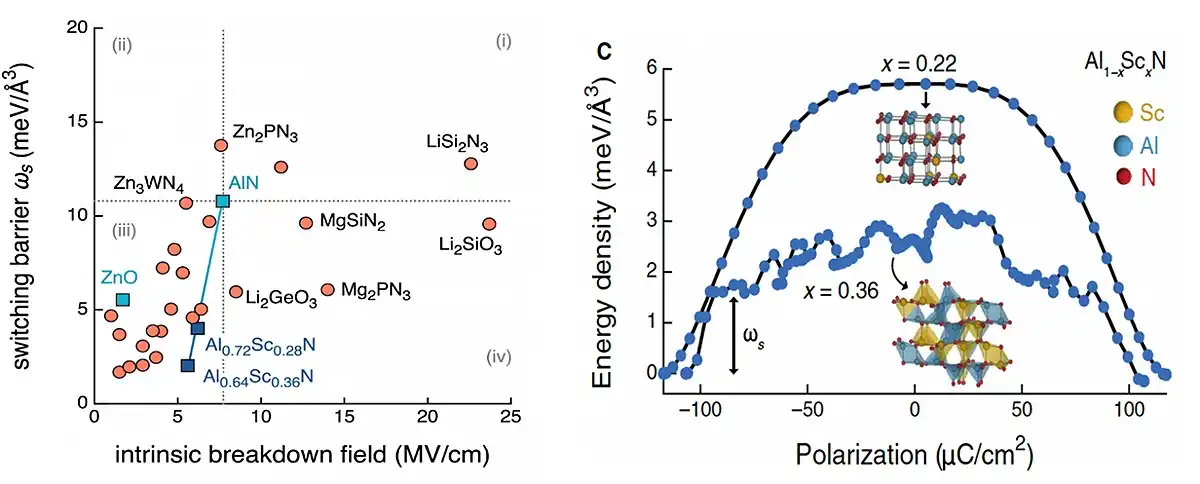Piezoelectric and Ferroelectric Materials Research
NLR's materials discovery and design work includes a piezoelectric and ferroelectric focus area. These materials are important for 5G and 6G telecommunications and promising candidates for energy-efficient nonvolatile memory applications.
Piezoelectric Materials
Piezoelectrics are materials that lack a center of symmetry to the crystallographic unit cell. Therefore, when a stress is applied to the crystal, the ions displace and cause separation of positive and negative charge centers. This enables the material to convert between mechanical energy (stress) and electrical energy (charge), in either direction.
Our team has investigated aluminum nitride-based alloys for increased piezoelectric performance, such as (Al,Sc)N with high scandium content and related materials. Particular attention is paid to metastable character of these nitride alloys.
For more information, see:
Structural and Optoelectronic Properties of Thin Film LaWN3, Physical Review Materials (2023)
Synthesis and Calculations of Wurtzite Al1–xGdxN Heterostructural Alloys, Chemistry of Materials (2022)
Review of High-Throughput Approaches to Search for Piezoelectric Nitrides, Journal of Vacuum Science & Technology (2019)
Implications of Heterostructural Alloying for Enhanced Piezoelectric Performance of (Al, Sc) N, Physical Review Materials (2018).

Ferroelectric Materials
Ferroelectrics are a subset of piezoelectrics with polar crystal structure, such that they also possess a spontaneous polarization (remains without applied field) in the unit cell, which can be reoriented by application of an electric field. In addition to (Al,Sc)N and related ferroelectric alloys, our team pursues the discovery and benchmark of nitride perovskites. Oxide perovskites are well known for possessing useful piezoelectric and ferroelectric properties, but much less is known about nitride perovskites.
For more information, see:
Low Leakage Ferroelectric Heteroepitaxial AlScN Films on GaN, arXiv (2024)
GdWN3 Is a Nitride Perovskite, Applied Physics Letters (2024)
Structural and Optoelectronic Properties of Thin Film LaWN3, Physical Review Materials (2023)
Anomalously Abrupt Switching of Wurtzite-structured Ferroelectrics: Simultaneous Non-Linear Nucleation and Growth Model, Materials Horizons (2023)
Local Chemical Origin of Ferroelectric Behavior in Wurtzite Nitrides, Journal of Materials Chemistry C (2022)
Reduced Coercive Field in Epitaxial Thin Film of Ferroelectric Wurtzite Al0.7Sc0.3N, Applied Physics Letters (2021)
Synthesis of LaWN3 Nitride Perovskite With Polar Symmetry, Science (2021).

New Materials Prediction and Realization
We are collaborating with the Colorado School of Mines to predict new piezoelectric and ferroelectric materials and elucidate their electrical response mechanisms. Recent examples include wurtzite ferroelectrics and related materials.

For more information, see:
Emerging Materials and Design Principles for Wurtzite-Type Ferroelectrics, Matter (2024)
Switching It Up: New Mechanisms Revealed in Wurtzite-Type Ferroelectrics, Science Advances (2024)
Enhanced Piezoelectric Response of AlN via CrN Alloying, Physical Review Applied (2018).
Projects
NLR's materials discovery work on piezoelectric and ferroelectric materials has been funded through a collaboration with Colorado School of Mines, by the National Science Foundation (NSF) and Defense Advance Research Project Agency (DARPA), and by NLR's Laboratory Directed Research and Development (LDRD) program.
This LDRD project explores novel potential multiferroic materials based on tetrahedral nitrides, inspired by the recent discovery of ferroelectricity in Al1−xScxN.
This project was funded by the NSF as part of the Designing Materials to Revolutionize and Engineer Our Future initiative (Grant No. DMREF- 2119281).
This project is funded by DARPA and its Tunable Ferroelectric Nitrides program (DARPA-PA-19-04-03).
Rebecca Smaha's Director's Fellowship LDRD project aimed to synthesize and characterize a novel family of materials: nitride perovskites containing rare earth cations.
This project was funded by the NSF as part of the Designing Materials to Revolutionize and Engineer Our Future initiative (Grant No. DMREF-1534503).
Research Collaborators
Geoff Brennecka – Characterization (Colorado School of Mines)
Prashun Gorai – Theory and computations (RPI)
Kei Yazawa – Ferroelectric and piezoelectric growth (Colorado School of Mines)
Nate Orloff – High-frequency dielectric measurements (NIST)
Contacts
Share
Last Updated Dec. 6, 2025
